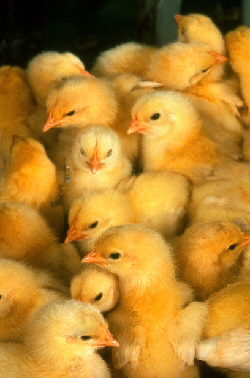



Developing Tools to Fight Marek’s Disease
Scientists with the USDA Agricultural Research service (ARS) are developing new tests and vaccines that are making it easier to detect viruses in chickens and protect them from the cancer-like diseases some of them cause.New tests and vaccines are making it easier to detect viruses in chickens and protect them from the cancer-like diseases some of them cause.

One of the latest tools developed by scientists at the Agricultural Research Service’s Avian Disease and Oncology Laboratory (ADOL) in East Lansing, Michigan, is a modified polymerase chain reaction (PCR) test to detect unique genetic sequences of both Marek’s disease and avian reticuloendotheliosis viruses in various tissues from chickens.
Marek’s disease is caused by a highly contagious herpes virus that primarily affects young adult chickens. It causes severe production losses and usually death and is spread from bird to bird by contaminated dust and dander in chicken houses. Avian reticuloendotheliosis, a retrovirus, infects a broader host range – chickens, turkeys, ducks, geese and quail. It can also cause tumors, production losses, and death in affected birds.
Diagnosis of these diseases includes taking tissue from the bird’s organs, preserving it in formalin, and examining it under a microscope.
“If a definitive diagnosis cannot be reached by gross and microscopic examinations, additional tissue must be obtained from affected chickens and sent to the laboratory for PCR or other tests,” said Aly Fadly, ADOL research leader. “These tests, called ‘immunohistochemistry’ and ‘virus isolation,’ require use of fresh or frozen tissue.”
Most, if not all, laboratories are equipped to preserve tissues in formalin and to process them further for microscopic examinations, Dr Fadly added. Now, the modified PCR allows any laboratory to extract virus DNA from preserved tissues to detect Marek’s disease and reticuloendotheliosis.
“This simple test offers poultry breeders, growers, and diagnosticians an effective alternative to current cumbersome biological and molecular tests that require use of frozen or fresh tissues,” he added. “It also lowers costs.”
To help prevent the spread of Marek’s and other avian diseases, commercial flocks are routinely vaccinated.
“However, we are seeing the emergence of more virulent viral strains of Marek’s disease virus,” Dr Fadly said. “Therefore, there is a critical need for improved vaccines to protect birds against highly virulent virus strains.”
While working at ADOL, former ARS scientist, Sanjay Reddy, developed a novel Marek’s vaccine called 'CVRM2'. He used state-of-the art molecular technology to generate CVRM2 from the best available commercial vaccine – CVI988 – and a 'promoter'. A promoter is a region of DNA that initiates gene transcription – the process by which genetic information is copied from DNA to RNA. The RNA sequences are then translated into amino acids to form specific proteins, and these proteins stimulate the immune system of the vaccinated host.
In laboratory and field trials, the new vaccine was as effective as or superior to the commercial vaccine in protecting chickens against highly virulent Marek’s disease viruses.
ARS recently approved a licence agreement with a private company to develop a commercial Marek’s disease vaccine from CVRM2.
Results of both the vaccine and modified PCR studies were published in Avian Diseases in 2013.
Further Reading
Go to our previous news item on this story by clicking here.
Find out more about Marek's disease by clicking here.
August 2014











